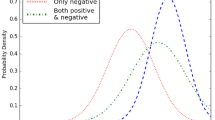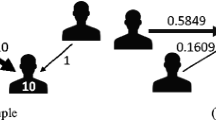Abstract
In this chapter, we present an approach to learn a signed social network automatically from online news articles. The vertices in this network represent people and the edges are labeled with the polarity of the attitudes among them (positive, negative, and neutral). Our algorithm accepts as its input two social networks extracted via unsupervised algorithms: (1) a small signed network labeled with attitude polarities (see Tanev, Proceedings of the MMIES’2007 Workshop Held at RANLP’2007, Borovets, Bulgaria. pp. 33–40, 2007) and (2) a quotation network, without attitude polarities, consisting of pairs of people where one person makes a direct speech statement about another person (see Pouliquen et al., Proceedings of the RANLP Conference, Borovets, Bulgaria, pp. 487–492, 2007). The algorithm which we present here finds pairs of people who are connected in both networks. For each such pair (P1, P2) it takes the corresponding attitude polarity from the signed network and uses its polarity to label the quotations of P1 about P2. The obtained set of labeled quotations is used to train a Naïve Bayes classifier which then labels part of the remaining quotation network and adds it to the initial signed network. Since the social networks taken as the input are extracted in an unsupervised way, the whole approach including the acquisition of input networks is unsupervised.
Access this chapter
Tax calculation will be finalised at checkout
Purchases are for personal use only
Similar content being viewed by others
Notes
- 1.
The system is restricted to only one person per quotation. It is assumed that the first person mentioned in the quotation is the main person to whom the quotation refers.
- 2.
The original definition was actually formulated for directed graphs and made use of the notion of “semi-cycle”, that is a closed directed walk of at least three nodes on the graph which is traversed ignoring the direction of the edges.
- 3.
Namely, if (v i , v k ) and (v j , v k ) are both positive, we enforce “+” on (v i , v j ), while if (v i , v k ) and (v j , v k ) have conflicting signs, then we enforce “–” on (v i , v j ).
References
Agrawal, R., Rajagopalan, S., Srikant, R., and Xu, Y. Mining newsgroups using networks arising from social behavior. In Proceedings of World-Wide Web Conference, Budapest, Hungary, pp. 529–535, 2003.
Allison, B. Sentiment detection using lexically-based classifiers. In To Appear in Proceedings of TSD’2008 Brno, Czech Republic, 2008.
Alrahabi, M. and Desclés, J.P. Automatic annotation of direct reported speech in Arabic and French, according to semantic map of enunciative modalities. In Proceedings of GoTAL conference, Gothenburg, Sweden, pp. 40–51, 2008.
Crockett, W.H. Inferential rules in the learning and recall of patterns of sentiments. Journal of Personality, 47(4):658–676, 1979.
Dave, K., Lawrence, S., and Pennock, D.M. Mining the peanut gallery: Opinion extraction and semantic classification of product reviews. In Proceedings of World-Wide Web Conference, Budapest, Hungary, pp. 519–528, 2003.
Davis, J.A. Clustering and structural balance in graphs. Human Relations 30:181–187, 1967.
Davis, J.A. The Davis/Holland/Leinhardt studies: An overview. In P.W. Holland and S. Leinhardt (eds), Perspectives on Social Network Research, New York, NY: Academic, pp. 51–62, 1979.
Efron, M. Cultural orientation: Classifying subjective documents by cociation [sic] analysis. In Proceedings of the AAAI Fall Symposium on Style and Meaning in Language, Art, Music, and Design, Washington, DC, pp. 41–48, 2004.
Hatzivassiloglou, V. and McKeown, K. Predicting the semantic orientation of adjectives. In Proceedings of the Joint ACL/EACL Conference, Madrid, Spain, pp. 174–181, 1997.
Hatzivassiloglou, V. and Wiebe, J. Effects of adjective orientation and gradability on sentence subjectivity. In Proceedings of the International Conference on Computational Linguistics, Saarbrücken, Germany, pp. 299–305, 2000.
Kim, S.M. and Hovy, E.H. Identifying and analyzing judgment opinions. In Proceedings of the HLT-NAACL conference, New York, NY, pp. 200–207,2006.
Knoke, D. Political Networks: The Structural Perspective. New York, NY: Cambridge University Press, 2003.
Krestel, R., Witte, R., and Bergler, S. Minding the source: Automatic tagging of reported speech in newspaper articles. In Proceedings of LREC conference, Marrakech, Morocco, 2008.
Mihalcea, R., Banea, C., and Wiebe, J. Learning multilingual subjective language via cross-lingual projections. In Proceedings of the ACL Conference, Prague, Czech Republic, pp. 976–983, 2007.
Montejo-Ráez, A., Ureña-López, L.A., and Steinberger, R. Text categorization using bibliographic records: Beyond document content. Procesamiento del Lenguaje Natural, 35: 119–126, 2005.
Mullen, T. and Malouf, R. Taking sides: User classification for informal online political discourse. Internet Research, 18:177–190, 2008.
Pang, B. and Lee, L. Opinion mining and sentiment analysis. Foundations and Trends in Information Retrieval, 2(1–2):1–135, 2008.
Pang, B., Lee, L., and Vaithyanathan, V. Thumbs up? Sentiment classification using machine learning techniques. In Proceedings of the Conference on Empirical Methods in Natural Language Processing, Morristown, NJ, pp. 79–86, 2002.
Pouliquen, B., Steinberger, R., and Best, C. Automatic detection of quotations in multilingual news. In Proceedings of the RANLP Conference, Borovets, Bulgaria, pp. 487–492, 2007.
Pouliquen, B., Tanev, H., and Atkinson, M. Extracting and learning social networks out of multilingual news. In Proceedings of the SocNet workshop, Skalica, Slovakia, pp. 13–16, 2008.
Riloff, E. and Wiebe, J. Learning extraction patterns for subjective expressions. In Proceedings of the Conference on Empirical Methods in Natural Language Processing, Morristown, NJ, pp. 105–112, 2003.
Steinberger, R., Pouliquen, B., and Ignat, C. Using language-independent rules to achieve high multilinguality in Text Mining. In F. Fogelman-Soulié, D. Perrotta, J. Piskorski and R. Steinberger (eds). Mining Massive Data Sets for Security, pp. 217–240. Amsterdam: IOS Press, 2008.
Tanev, H. Unsupervised learning of social networks from a multiple-source news corpus. In Proceedings of the MMIES’2007 Workshop Held at RANLP’2007, Borovets, Bulgaria. pp. 33–40, 2007.
Turney, P. Thumbs up or thumbs down? Semantic orientation applied to unsupervised classification of reviews. In Proceedings of the Association for Computational Linguistics, Philadelphia, PA, pp. 417–424, 2002.
Wasserman, S. and Faust, K. Social network analysis: Methods and applications. Cambridge: Cambridge University Press, 2008.
Wilson, T., Wiebe, J., and Hwa, R. Just how mad are you? Finding strong and weak opinion clauses. Computational Intelligence, 22(2):73–99, 2006.
Yang, B., Cheung, W., and Liu, J. Community mining from signed social networks. Transactions on Knowledge and Data Engineering 10:1333–1348, 2007.
Yu, H. and Hatzivassiloglou, V. Towards answering opinion questions: Separating facts from opinions and identifying the polarity of opinion sentences. In Proceedings of the Conference on Empirical Methods in Natural Language Processing, Morristown, NJ, 129–136, 2003.
Acknowledgments
We would like to thank the whole team working on the Europe Media Monitor for providing the valuable news data. Their research and programming effort laid the foundation which made this experimental work possible.
Author information
Authors and Affiliations
Corresponding author
Editor information
Editors and Affiliations
Rights and permissions
Copyright information
© 2010 Springer US
About this chapter
Cite this chapter
Tanev, H., Pouliquen, B., Zavarella, V., Steinberger, R. (2010). Automatic Expansion of a Social Network Using Sentiment Analysis. In: Memon, N., Xu, J., Hicks, D., Chen, H. (eds) Data Mining for Social Network Data. Annals of Information Systems, vol 12. Springer, Boston, MA. https://doi.org/10.1007/978-1-4419-6287-4_2
Download citation
DOI: https://doi.org/10.1007/978-1-4419-6287-4_2
Published:
Publisher Name: Springer, Boston, MA
Print ISBN: 978-1-4419-6286-7
Online ISBN: 978-1-4419-6287-4
eBook Packages: Business and EconomicsBusiness and Management (R0)





